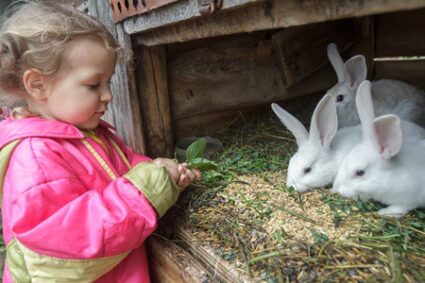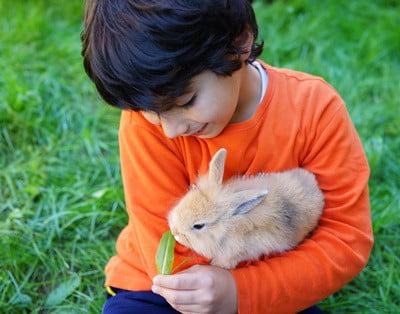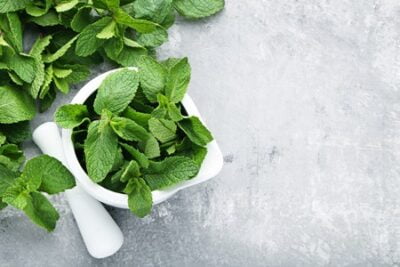Mint is a common staple in grocery stores. It can be found alongside other healthy greens that are good for a rabbit’s diet. If you have ever wondered whether mint can be fed to rabbits, we have some excellent news for you. All parts of a mint plant can be fed to rabbits.
Mint is a healthy herb that can be fed to rabbits in small amounts. Not only is it tasty, but it has many health benefits. All parts of the mint plant can be eaten, including the leaves and stems. While the roots aren’t toxic, they aren’t nutritious either. When feeding mint to rabbits, it’s advisable to only offer the leaves, flowers, and stems.
Other than being a nutritious part of a rabbit’s diet, mint is also a plant that has medicinal properties. Mint can be given to rabbits with digestive tract issues, as well as those weaning to prevent mastitis.
Can Rabbits Eat Mint?
Mint can refer to many types of plants. Most mint plants fall under the genus mentha, which includes plants like spearmint, peppermint, and thyme. Other plants that are colloquially called mint fall under the larger Lamiaceae family, which the genus mentha falls under. This larger family includes herbs like balm mint, sage, and basil.
All mint varieties are safe to feed to rabbits, except for pennyroyal. All parts of ‘safe’ mint plants can be fed to rabbits. However, the root is not a good source of nutrients.

Should Rabbits Eat Mint Leaves?
Because it is where most of the oil of the plant is stored, the mint leaf is the most flavorful and aromatic part of the mint plant. When cooking, the mint leaves are used to provide flavor and aroma to a dish. For rabbits, a mint plant’s leaves are a goldmine of health benefits and flavor.
To get the most flavor and medicinal properties from the mint leaves, harvest the leaves just before it flowers. This is when the mint has the most amount of oil, increasing its therapeutic properties, as well as its taste.
Should Rabbits Eat Mint Flowers?
All mint plants tend to have small clustered flowers. Depending on the variety, these flowers can be purple, pink, or white in color. Like the leaves, the mint’s flowers are also full of flavor, although they have a more fruity taste compared to the leaves.
Like the leaves, mint flowers are also safe to eat for rabbits. This makes mint flowers an alternative for rabbits who find mint’s flavor too strong.
Should Rabbits Eat Mint Stems?
You probably haven’t seen mint stems in dishes, as they are often eschewed for the more appetizing leaves. However, mint stems also have the same sharp, minty flavor that can be found in the leaves
The stems close to the leaves and the tips of the shoots are the softest part of the stem. However, if your rabbit doesn’t seem to be having a hard time chewing the stem in its entirety, feed the whole stem to your rabbit.
Should Rabbits Eat Mint Root?
While mint root isn’t toxic to rabbits, it’s not nutritious either. Unlike some plants, the roots of mint do not have any nutritional value. When it comes to mint plants, it’s better to only use its leafy greens and stems.
What Kinds Of Mint Are Toxic To Rabbits?
Most of the plants in the mint family are safe for rabbits. However, there are some plants that are considered toxic, such as pennyroyal.
There are two types of pennyroyal, the European pennyroyal, and the American pennyroyal. The European pennyroyal, Mentha pulegium, is colloquially called pennyrile, squaw mint, and pudding grass.
On the other hand, the American pennyroyal, Hedeoma pulegioides, is also called mock pennyroyal and false pennyroyal, and to make things more confusing, also squaw mint.
You probably won’t need to differentiate one from the other. While both are different plants, they both have similar uses, as well as similar toxicity.
Pennyroyal Identification
The pennyroyal can be most easily identified by its flowers. The American pennyroyal is pale blue, while the European pennyroyal is lilac in color.
The European pennyroyal has leaves similar to that of spearmint, while American pennyroyal has more slender and erect leaves. Both have a minty odor when crushed, similar to other plants in the mint family.
Healthy Mint Plants for Rabbits
Aside from pennyroyal, plants from the mint family are safe to feed to your rabbit. Here are some mint plants that can be ingested:
Lemon Balm
Lemon balm, Melissa officianalis, is a small plant, growing from 28 to 59 inches tall. Aside from aiding in indigestion, it can also reduce stress.
Peppermint
Peppermint is a hybrid of the watermint and spearmint. It grows from 12 to 35 inches tall. It has long, broad, and slightly fuzzy leaves with a reddish vein, and blooms whorls of purple flowers.
Peppermint is known to contain a high concentration of natural pesticides and is used in organic gardening to repel rodents. Other than aiding in digestion, peppermint can also be used to aid against flatulence in rabbits.
Rosemary
Rosemary is a plant known for its needle-like leaves. They bloom white, pink, purple, or blue flowers.
Other than being a tasty treat both dried and as a tea, rosemary has a lot of health benefits to rabbits. Rosemary can aid in digestion, as well as weakness, circulation, and depression in rabbits.
Lavender
As a small shrub, this herb from the mint family is known for its relaxing aroma. For rabbits, lavender has been known to aid in appetite stimulation, pain relief, circulation, and gas.
Can You Give Rabbits Mint Tea?
To give mint to your rabbits, simply brew a cup of tea and let it cool. Do not add any other ingredients, as they can be unsafe for rabbits.
If available, you can also brew your own cup from a tea bag. Just make sure that it’s only filled with mint leaves and nothing more. Once cooled, serve the tea to your rabbits in a dish. On colder days, serve the tea slightly warm.
While mint tea is a great drink for your rabbits, some of them just might eschew the drink for regular water, even if they don’t mind the leaves themselves.
Mint Benefits
Not only does mint have a great taste, but it has a lot of health benefits as well. Here are some of the health benefits that rabbits can gain from mint:
- Balanced diet: Mint is high in fiber and low in calories and sugar, three components that make up a balanced rabbit diet.
- Vitamins: Mint contains vitamins A, C, and B complex.
- Antioxidants: Herbs are known to be rich in antioxidants, and according to a study in Phytotherapy Research, mint is no different. Antioxidants have been known to avoid different illnesses like arthritis, memory loss, and even cancer.
- Minerals: Aside from vitamins, mint is also rich in calcium, iron, phosphorus, magnesium, zinc, manganese, and copper.
Mint As A Remedy
Other than its health benefits, mint can also be used as a remedy for illnesses. In Ancient Science Life, scientists determined that these folk remedies do hold a stake under scientific scrutiny. In fact, these traditional uses are still being practiced in different parts of the world today.
Even in rabbits, mint has been known to aid in different ailments. Here are some ways that mint can be used as a medicine for rabbits:
- Indigestion: The high fiber content of mint plants can aid in indigestion in rabbits. It is a common go-to remedy for owners with rabbits who have digestive tract blockages.
- Loose stool: Mint can help rabbits who have loose or watery stools.
- Flatulence: While being a normal bodily function, too much flatulence can be painful. Thankfully, mint has been shown to be an effective remedy against gas, alongside other digestive problems.
- Brain performance: Because of the nutrients and minerals available in mint pants, mint is believed to aid in improving brain performance.
- Stress: The lemon balm and lavender plants have been known to reduce stress, alongside being antibacterial and antiviral.
Can Nursing Rabbits Have Mint?
Mint plants should not be given to rabbits who are nursing. Mint has been known to dry up a rabbit’s milk. Nursing rabbits should not be fed mint, alongside parsley, sage, and other herbs from the mint family.
On the other hand, this effect can be used in a beneficial manner. This effect of mint can be helpful to does who are weaning their kits. Weaning rabbits are at a higher risk for developing mastitis, but the milk-drying effect of mint plants can prevent this illness.
How To Give Mint To Your Rabbit
Raw mint is safe to feed to your rabbit. However, not all plants are prepared equal. Here are some ways to make mint healthier and safe:
- Wash mint: Mint bought from the grocery may have been sprayed with chemicals. If you didn’t source the mint yourself, it is best to rinse the mint thoroughly under running water.
- In small pieces: To ensure that the flavor isn’t too much for your rabbit, shred the leaves into small pieces and sprinkle it over the rest of their food.
- Mix it up: Dried herbs can be too strong a taste for rabbits. When fed to your rabbits, dried mint herbs are better served when dispersed over wet vegetables and hay.

Rabbit Ate Too Much Mint
While mint is a great plant to feed for your rabbit, it is possible to give your rabbit too much. For one thing, mint and other herbs shouldn’t make up the majority of your rabbit’s diet. Rather, rabbits should be mainly fed grass hays, with vegetables and fruits given as a supplement.
How do you know that your rabbit has eaten too much mint? Make sure to keep an eye out for the following symptoms:
- Painful bowel movements
- Straining during bowel movements
- Discolored or oddly-shaped stools
- Loss of appetite
If you notice any of these symptoms, reduce the vegetables you’re feeding to your rabbit. Then, schedule an appointment with your vet.
Do Rabbits Like Mint Plants?
There are some rabbits who do not like the smell or find the taste too strong. Most of the time, owners report their rabbits enjoying the plant. Some rabbits have to be given a bit of time to get used to the plant, but most eventually learn to love its smell and taste.
However, if you want to feed mint to a doubtful rabbit, there are some things you can do to increase your chances. Here are a few ideas to convince your rabbits to munch on mint:
- Introduce the herb: Some rabbits would like to explore their food before eating it. If your rabbit hasn’t seen mint before, let it smell the plant before feeding. Your rabbit may not like it at first and ignore the leaf. In due time, some rabbits may end up taking a nibble.
- Start slow: Like most herbs, mint should be given in small amounts, especially when you are first feeding it to your rabbit. This will help you figure out what amount of mint is healthy for your bun and avoid overfeeding.
- Mint flowers: Mint flowers have a less sharp taste than the leaves, swapping out sharpness for fruitiness. If your rabbit doesn’t want to eat mint because of the taste, try offering mint flowers.
- Have them explore: Allowing your rabbits to explore all on their own can help you figure out whether they like mint or not. It is possible that your rabbit does like mint, but not the kind that you’re feeding it. Left to their own devices, rabbits can pick and choose which leaves are most appealing to them.
If you’ve done all you can to add mint plants to your rabbit’s diet to no avail, don’t force your rabbit. What one rabbit likes will not be liked by another. With perseverance, you’ll figure out your rabbit’s preferences, and put them on the path to a healthier and happier life.

